Editor’s note: The following collection of immigration reporting resources, story ideas and examples is the third in a series of tip sheets for new and experienced journalists covering immigration at the local and community levels. This tip sheet series is made possible through funding from the Catena Foundation. You can read the entire collection here.
Twenty-five journalists from news outlets across the country had just arrived at the El Paso/Juarez border for a three-day Poynter Beat Academy reporting workshop when they found themselves at ground zero of a national news story on immigration.
On June 4, the day they arrived, President Joe Biden issued an executive order effectively halting asylum processing at and between major ports of entry for migrants who show up without a prior appointment.
The group of journalists I was helping to train grew excited by the timing — as did I. Timing and location are essential to journalism. As a working journalist, I have been lucky to cover the 1980 Mariel boatlift from Miami, the passage of IRCA in 1986 from Washington, D.C., and a migrant labor strike in West Central Florida that threatened to turn violent. The journalists and I had high expectations for the stories emerging from the day’s historic border announcement.
Our enthusiasm dissolved when we learned from city officials on both sides of the Rio Grande that the immediate impact was minimal: Migrant numbers have been falling for weeks and months. This Border Report story notes that in the El Paso sector, the Border Patrol encountered 560 migrants daily in June, compared with 750 daily in May. Customs and Border Patrol reported 170,723 migrant encounters in May, a huge decline from 301,983 in December. Although migrant arrivals typically decline in the summer because of sweltering desert heat, other recent policy changes and deterrence actions by Mexico also contributed to the seven-month decline, officials said.
El Paso Mayor Oscar Leeser, following Biden’s announcement in Washington, D.C., returned to El Paso to meet with the Poynter journalists, telling us that while the directive is a step in the right direction, its long-term impact remains to be seen. Our journalists also heard from a representative for recently reelected Juarez Mayor Cruz Pérez Cuellar, who expressed doubt that restrictive measures like the order will stop desperate migrants from fleeing their dangerous home countries to enter the U.S.
Over the following two days, we listened to city emergency officials, shelter providers, business leaders, social workers and local journalists who cover immigration regularly explain how the sister cities have handled past surges in migrant arrivals with assistance from the Federal Emergency Management Agency, local nonprofits and church organizations.
-
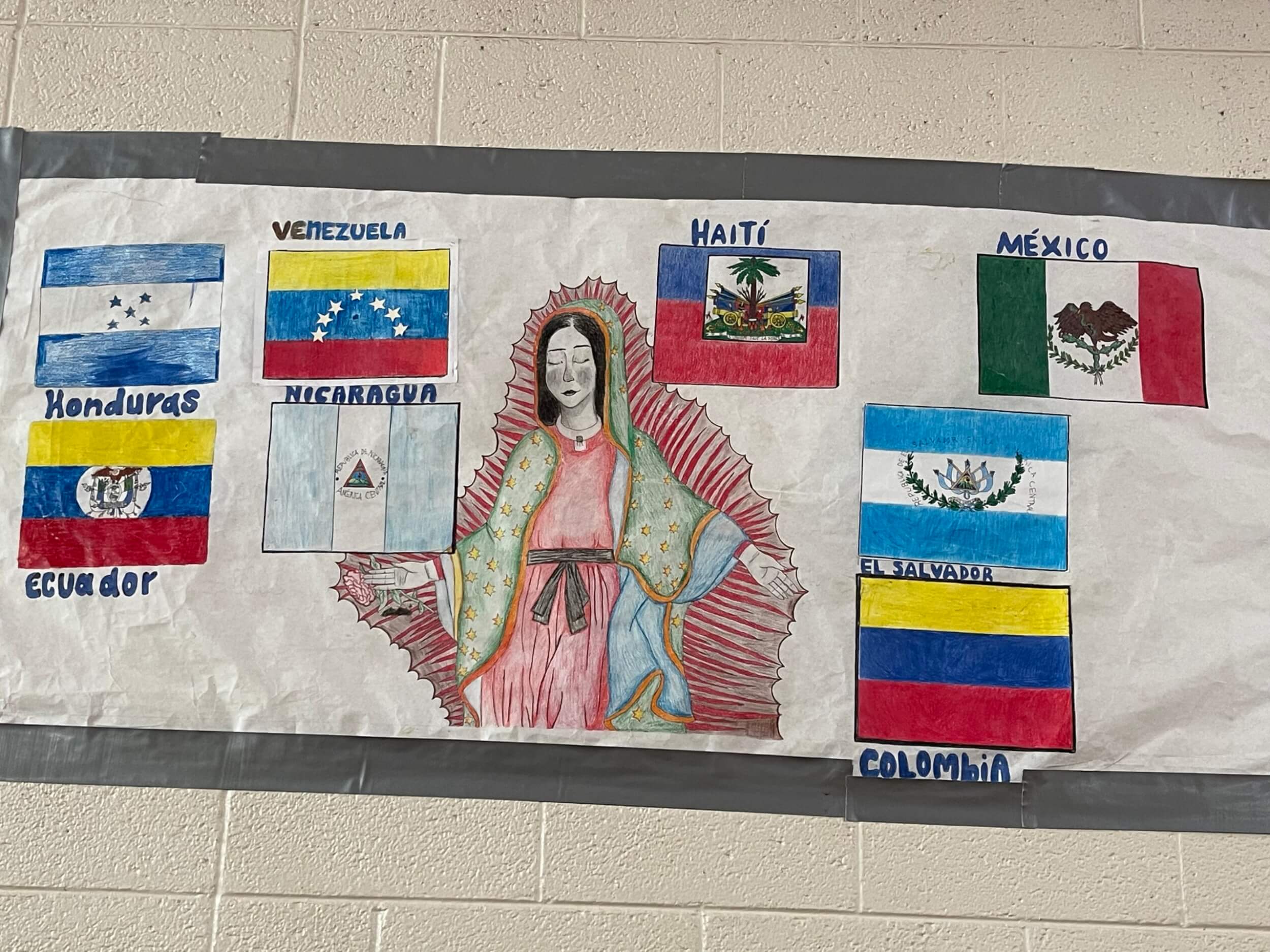
Hand-made posters like this one displaying the flags of migrants’ countries of origin line the shelter walls. The Virgin of Guadalupe is at the center. (Courtesy: Zita Arocha)
Sacred Heart shelter, a rest stop on a long journey north
While some journalists spent five hours on a Border Patrol tour of the border wall, which runs next to the Rio Grande, I visited a local church-run shelter with a smaller group of reporters. When we arrived at Sacred Heart shelter in Segundo Barrio, El Paso’s oldest and poorest immigrant neighborhood, some men waited at a street corner for an offer of a day’s work. Others crouched on the sidewalk across the street from the shelter, their newly washed pants and shirts hanging from the iron fence behind them.
Inside the converted gym next door to the Catholic church, families and single men waited in an orderly line carrying luggage, stuffed toys and personal belongings to hear the call for a bus to their destination — Denver, New York and Chicago, paid for by the state of Texas. Some migrants or their sponsors pay for their transportations to other cities. El Paso County also transports migrants once a week by bus to Dallas or Houston.
Shelter director Michael DeBruhl, a former Border Patrol officer, led us on a tour of the well-organized, light-filled shelter, which included a stage with tables loaded with personal items for the arrivals, a spotless kitchen, and a closet with racks of donated clothes and shoes.
-
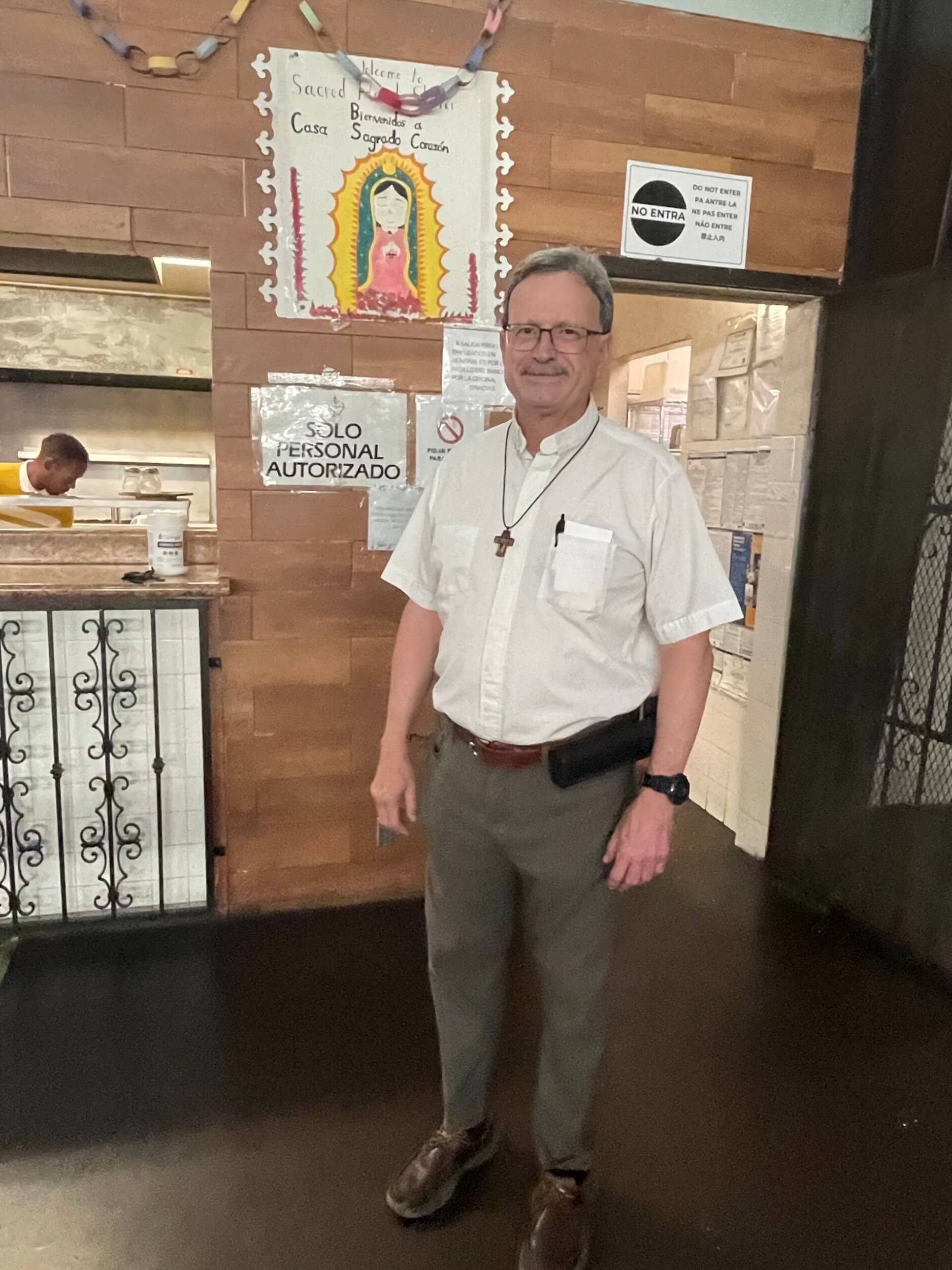
Father Ruben Garcia, a Jesuit priest, stands at the shelter’s kitchen door, where migrants receive three hot meals a day. (Courtesy: Zita Arocha)
At night, the migrants, most from Venezuela, lay their gray sleeping mats on the polished wood floor, wipe them down in the morning, and stack them neatly along a concrete block wall to make room for tables and chairs where migrants eat, converse and meet with staff — or sometimes a lawyer.
-
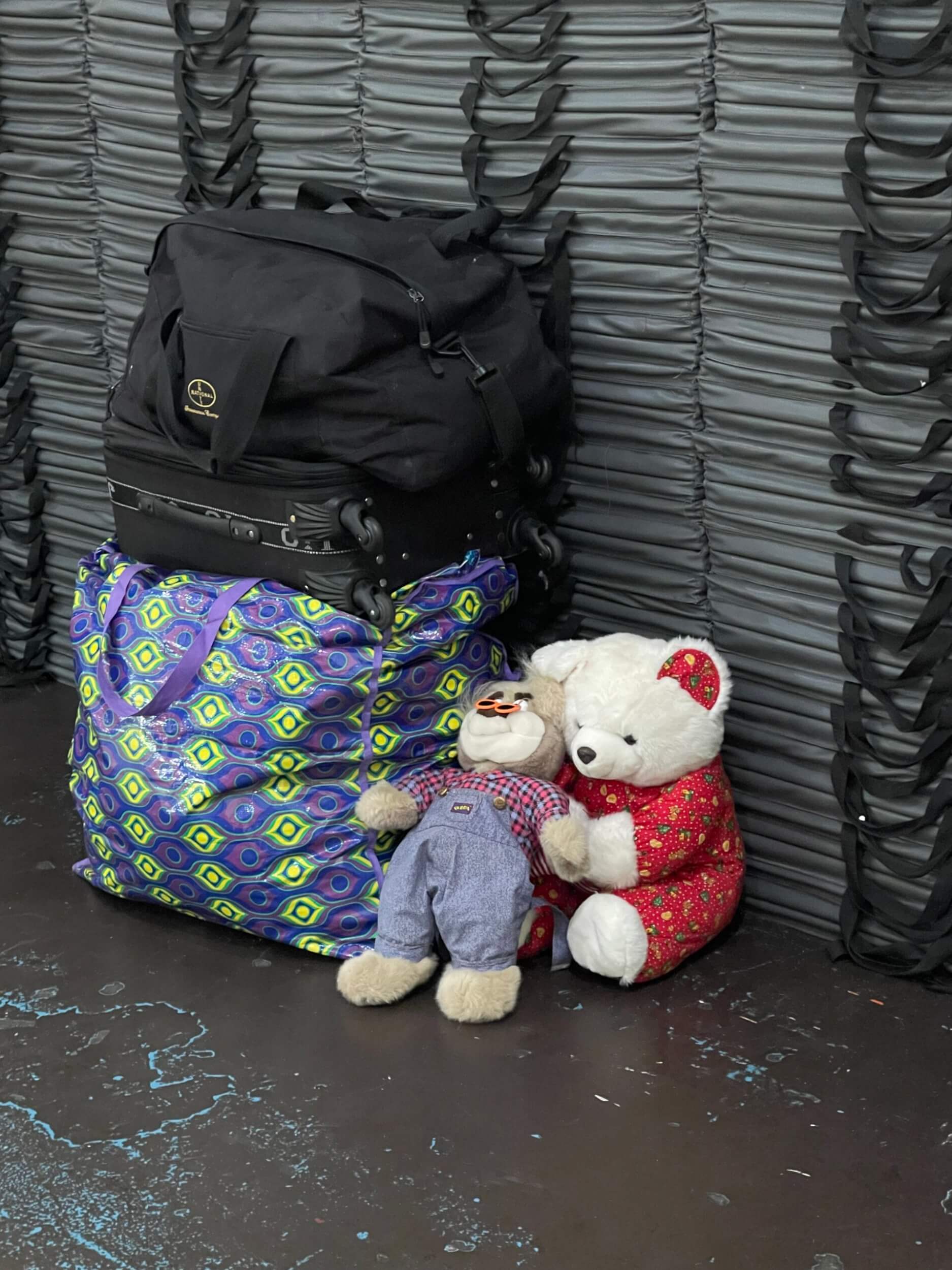
The tired travelers wipe down and stack their gray mats against the wall each morning. (Courtesy: Zita Aroche)
Children spend the day drawing in a corner or watching television.
-
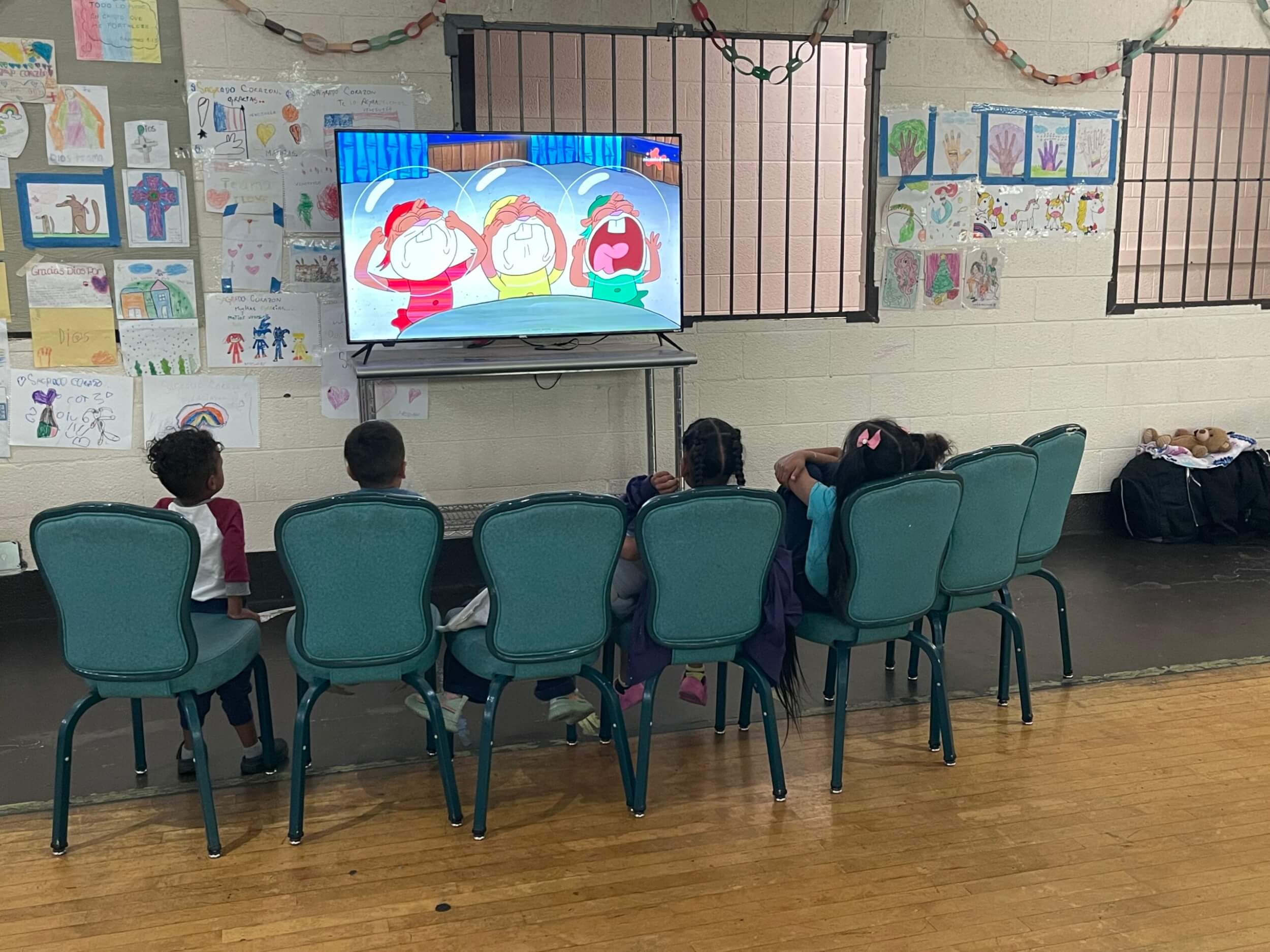
Children spend the day watching cartoons and drawing while their parents arrange transportation to their destinations. (Courtesy: Zita Arocha)
Their artwork is displayed along the concrete walls of the shelter, as is a large map of the United States so the migrants can trace the route from El Paso to their destination.
Most migrants remain at the shelter for a few days, sometimes a week, until they head north, DeBruhl said. Health care providers visit weekly to treat minor ailments, such as high blood pressure, migraines and sprains, and perform health screenings.
Father Ruben Garcia, who acts as an unofficial space coordinator for the network of El Paso shelters, said the migrants are under “enormous amounts of stress,” not only because of the long, dangerous trek north from South and Central America or other far-flung countries across the globe but also because of uncertainty about where they go next. At sunset each day, he holds mass in the gym for the tired travelers.
DeBruhl added: “This place is just a rest stop before they resume their journey.”
-
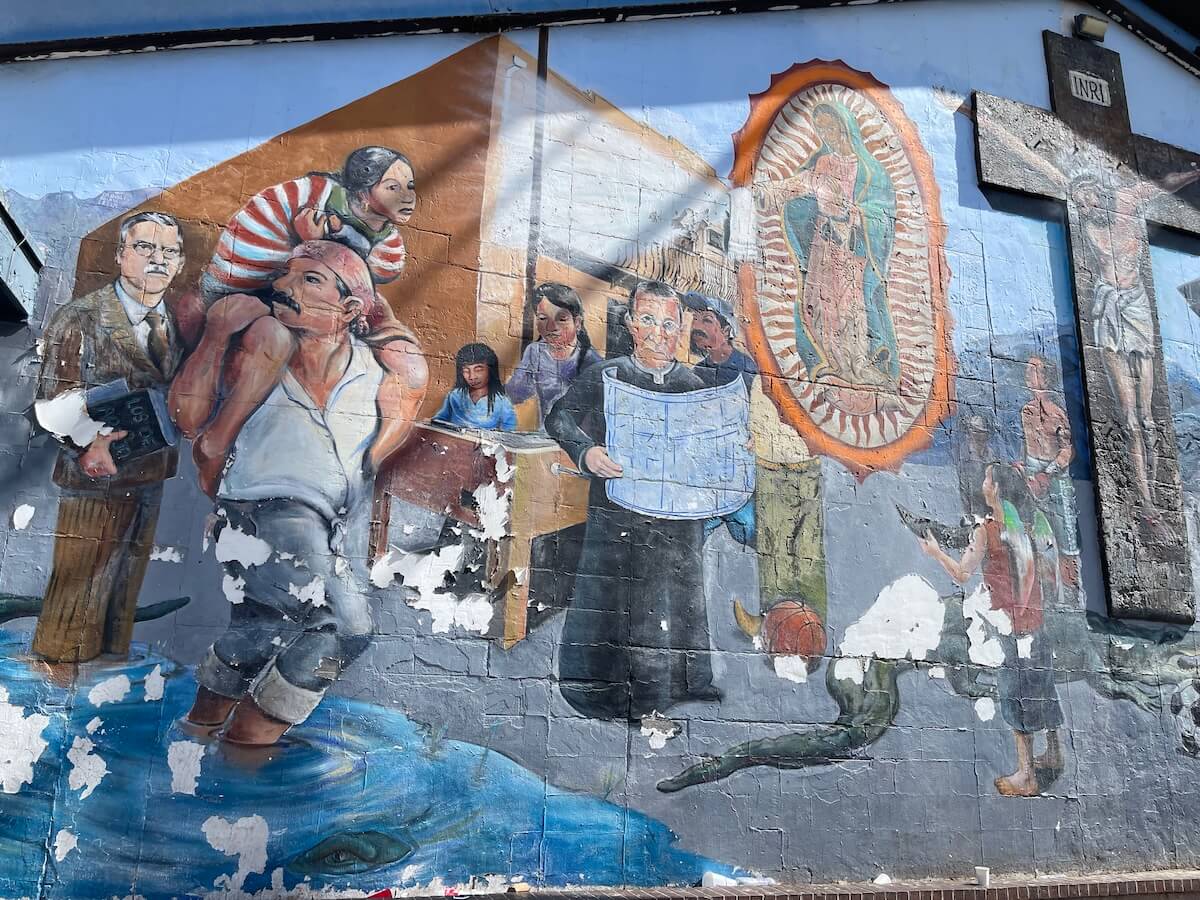
One of El Paso’s many colorful murals. This one is next door to Sacred Heart shelter and shows a migrant crossing the Rio Grande carrying a woman on his back. (Courtesy: Zita Arocha)
Story idea
Is there a church-run shelter in your community that provides temporary shelter to migrants? How are they set up? What services do they provide? How long can migrants stay? Is the shelter helping both unhoused people and migrants? If so, what is the impact on the unhoused population? Has the shelter received additional government funding to serve migrants and the unhoused? Do shelter workers help migrants move into more permanent housing and find work?
News reporting by Poynter journalists from the ground in El Paso
When the tour concluded, the visiting journalists dispersed to interview the waiting migrants — some inside the gym and others outside on the sidewalk. One bilingual journalist offered to translate for non-Spanish speakers.
After returning home, the reporters began producing compelling stories about their visit: a Venezuelan family denied asylum, some from the Juarez side of the borderline; a Congolese migrant who made it to Seattle; a family from Venezuela who arrived the night before the border closure and is headed for Nashville; as well as an extensive interview with the El Paso mayor. Here are some of their stories:
Venezuelan family traveled for 3 months, only to be denied asylum claim at the border, by Michelle Jokisch Polo, NPR
Q&A: Border City Mayor Backs Biden on Asylum Shutdown, by Elliott Davis Jr., U.S. News and World Report
On the U.S.-Mexico border, hopes and fears after Biden’s order limiting asylum, by Ariana Figueroa, News from the States
‘It came a shock to us’: Migrants brace for full impact of Biden’s asylum ban and ‘Don’t want to get stuck:’ Migrants at Juárez border feel pressure of asylum changes, by Anna-Catherine Brigida, Houston Landing
Migrants flee suffering, endure jungle to seek asylum in Seattle, by Nina Shapiro, The Seattle Times
More on the asylum executive order
Biden’s June 4 order stops asylum processing at the southern border when migrant arrivals reach a seven-day daily average of 2,500 and remain at that level for two weeks.
Theoretically, asylum processing will resume when the figure drops to 1,500 daily for seven days in a row for two consecutive weeks. According to CBP data, daily migrant arrivals topped 5,500 in May along the southwest land border.
Given the numbers, it’s uncertain when and if asylum processing will resume and may depend on the outcome of an immediate court challenge by the ACLU and other human rights organizations.
Is Biden’s border restriction order more hype than bite?
The immediate excitement about the asylum order from some immigration hardliners and disappointment from activists and civil rights organizations seems exaggerated.
Last year, when border arrivals were at a high point, the executive branch began to implement solutions, such as creating an asylum appointment app and regional processing centers in Latin America where immigrants can explore other legal pathways to enter the U.S. The measures are designed to streamline and quickly process and monitor asylum seeker applications.
Some political analysts say Biden’s new asylum directive is an election-year ploy to allay voters’ fears over uncontrolled immigration at the border, and they may have a point. Immigration ranks second or third, depending on which polls you cite, as a top concern among potential voters in the coming presidential election between two unpopular candidates who hold vastly opposing views on undocumented immigration. Republican candidate Donald Trump has called for mass deportations if he is elected. At the same time, Biden has been considered soft on the issue by refusing to take aggressive action to halt undocumented migration.
An app and regional processing centers to better manage asylum seekers’ requests
A year ago, the Department of Homeland Security released a CPB app that allows asylum-seekers and other migrants stranded in Central and Northern Mexico to secure an immigration appointment before traveling to the border. The intent is to deter migrants from arriving at the border unannounced. It seems to be having a modest impact.
Although there have been technological glitches with the CBP app, it has processed 170,000 applications in the first six months of the previous year.
The other action by the Department of Homeland Security to deter migration occurred with the expiration a year ago of Title 42, the health protocol implemented by Trump that barred migrants from entering the U.S. because of the pandemic.
Biden announced in 2023 the creation of regional processing centers called Safe Mobility Offices, starting with Guatemala and Colombia, with other countries added later. The idea is to pre-screen and process migrants through the regional centers to deter mass migration to the southern border. U.S. officials believe the centers will expedite requests for humanitarian protection and provide legal pathways to enter the U.S., including employment-based visas, family reunification and sponsorships. This DHS fact sheet explains the measure.
A fundamental uncertainty is whether the centers will be adequately funded and fully operational soon. If not, their power to curtail migrant arrivals at the border will be limited, policy analysts said.
Story idea: Monitor the numbers processed by the CBP app between now and the November election. Talk to DHS officials, immigration researchers and policy analysts to determine the app’s impact on suppressing migration arrivals at the border.
Story idea: Report on the current status and operation of the regional centers in Guatemala and Colombia. Are they up and running? Which agency funds them, and at what level? Is there long-term funding to open more? How many are being processed?
Mexico holds the key to reducing encounters at the U.S. border
In the run-up to Mexico’s national and local elections last month, the federal police and migration officers began a campaign to transport migrants from Central and Northern Mexico to cities at its southern border. The country has been coping for several years with hundreds of thousands of migrants from Central and South America, as well as from Asia, Africa, China and Eastern Europe, traveling through Mexico to seek asylum at the border. As in the U.S., Mexican citizens worry about the social and economic impact of the growing number of transient migrants.
Mexico’s migrant transport south follows several personal conversations between Biden and President Andrés Manuel López Obrador and high-level negotiations on migration that began late last year. News sites, including USA Today and the The Associated Press, have reported on the relocation of migrants to southern cities like Villahermosa and Tapachula. According to news reports, migrants are usually dropped off in shelters and released a few days later. Migration activists say many will resume the trek north.
Andrew Selee, executive director of the Migration Policy Institute, told USA Today that declining numbers at the border aren’t because of “busing in Texas,” a reference to the state’s decision to transport asylum seekers to Democratic urban centers throughout the U.S.
“The numbers are down because of busing in Mexico,” he said.
Coincidentally, two days before Biden’s asylum policy announcement, Mexico elected a new president: Claudia Sheinbaum, a left-wing climate scientist and member of Movimiento Regeneración Nacional, known as Morena, the party of current President López Obrador. The new president hasn’t publicly stated her position on migration through Mexico.
Story idea: With the Mexican election concluded, will the country continue moving migrants south until the U.S. presidential election in November to help Biden? The president and his Republican challenger, Trump, hold opposing views on immigration. Trump has called for deporting undocumented migrants if he is elected, and until his recent order restricting asylum, potential voters considered Biden soft on controlling immigration at the border. Journalists should keep an eye on this developing story.
Read more Immigration Matters here.
Correction, July 2, 3:30 p.m. Eastern: This story has been updated to clarify language around immigration processing at the border. Immigration officials continued processing migrants, and people could still seek asylum if they had made an appointment to ask for asylum, and under certain other very specific circumstances.
A previous version of this story incorrectly stated that the federal government pays for migrant bus fare to several cities. In actuality, the fares are paid for by the state of Texas for travel to Denver, New York and Chicago (not Seattle, as previously stated). That section of this tip sheet also has been updated to indicate other transportation payees and options.
Additionally, there is no option at Latin American processing centers to apply for asylum, only to explore other legal avenues for immigration into the United States.







